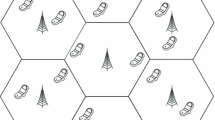Abstract
In the preceding chapter, a globally optimal way to achieve rate tuples lying on the boundary of the capacity region was presented using the weighted sum rate maximization approach. In order to realize such a Pareto optimal rate tuple, dirty paper coding has to be applied which is attended by a very high computational complexity.
Access this chapter
Tax calculation will be finalised at checkout
Purchases are for personal use only
Similar content being viewed by others
Notes
- 1.
We restrict ourselves to the real-valued implementation of dirty paper coding for the complexity analysis. Since the inphase and quadrature component are independent, the complex-valued case corresponds to applying real-valued dirty paper coding two times. Due to the fact that the scalar \(\lambda \) in (7.1) is equal to one in Costa’s correspondence, the following expressions look slightly different to those in [76].
- 2.
Equivalently, the user could simply be dropped from the system model.
- 3.
For \(L=1\) when only a single data stream is active, the gradient-projection algorithm need not be run actually. In this case, the optimum precoder of user \(k\) is given by the dominant eigenvector of the channel Gram \(\varvec{H}_k^\mathrm{H}\varvec{H}_k\).
- 4.
Since the global maximum of the sum rate is unknown due to the nonconvexity of the problem, we plot the relative distance to the maximally achieved one.
- 5.
This holds as long as the canonical unit vectors are not eigenvectors of the channel Gram that do not correspond to the maximum eigenvalue.
- 6.
The sum of two rank-one matrices may have rank two for example.
- 7.
Author information
Authors and Affiliations
Corresponding author
Rights and permissions
Copyright information
© 2013 Springer-Verlag Berlin Heidelberg
About this chapter
Cite this chapter
Hunger, R. (2013). Linear Transceiver Design for the MIMO BC. In: Analysis and Transceiver Design for the MIMO Broadcast Channel. Foundations in Signal Processing, Communications and Networking, vol 8. Springer, Berlin, Heidelberg. https://doi.org/10.1007/978-3-642-31692-0_7
Download citation
DOI: https://doi.org/10.1007/978-3-642-31692-0_7
Published:
Publisher Name: Springer, Berlin, Heidelberg
Print ISBN: 978-3-642-31691-3
Online ISBN: 978-3-642-31692-0
eBook Packages: EngineeringEngineering (R0)




